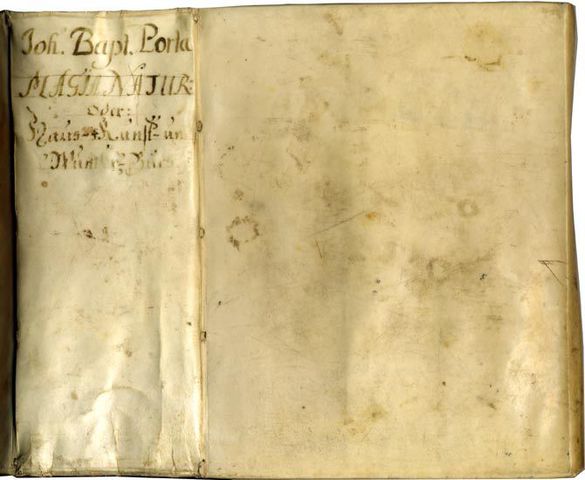PORTA, Giambattista della (1535-1615)
Magia naturalis, oder Hauß-, Kunst- und Wunder-Buch, Welches Zuerst von demselben Lateinisch beschrieben; hernach von Ihm selbst vermehret; nunmehro aber allen Liebhabern der natürlichen Wissenschaften zum besten, nicht nach dem alten Druck der Französischen Edition, darinnen nur vier Bücher; sondern durch alle zwantzig Bücher gantz aufs neu in die Hochteutsche Sprach übersetzet ... und in zweyen Theilen, heraus gegeben durch Christian Peganium, sonst Rautner genannt.
Nurnberg, Bey Johann Ziegers seel. Wittwe, 1713.
















The second and best German edition of Porta’s popular Magia naturalis; the first German edition, a small octavo in two volumes, appeared in 1680. The present quarto edition with all the twenty books (chapters) is certainly the most comprehensive of all editions, greatly enlarged with 'Anmerckungen’ and additions by the editor and translator, “Christian Peganium, sonst Rautner genannt” who acc. to Krivatsy a.o. is the pseudonym for Christian Knorr von Rosenroth (1639-1689), the German Baroque poet famous for his hymn “Morgenglanz der Ewigkeit” and for his profound knowledge of oriental languages. Under the influence of the mystic Franz Mercurius van Helmont and through the study of natural science, mysticism and Cabbala, Knorr von Rosenroth searched to find the vitalistic explanations for the most obscure phenomena of nature. His edition of Porta’s Magia naturalis has a frontispiece portrait of the magician himself and fine and curious plates with genre scenes representing the various themes of each of the twenty books. They have a naive but irresistible charm and their impressions in this copy are exceptionally fine. According to his own statement, Porta composed the first books or chapters of his Magia naturalis at the early age of fifteen. It was first published in Naples in 1558 and reproduced several times. The early editions contained only four books which were increased to twenty in the expurgated and amplified edition of Naples 1589, which is Porta’s best-known work and the basis of his reputation. It is an extraordinary hodgepodge of material representing that unique combination of curiosity and credulity common in the late Renaissance. The twenty books deal with the most varied subjects with a strange mixture of superstition and knowledge. Porta founded the first scientific society in Europe, the Academia dei Segreti, where the members discussed and studied the secrets of nature. Porta’s academy was closed by the order of the Inquisition and all further publications of his dangerous work was prohibited. This ban was lifted in 1592. Of special interest is that Porta in his Magia naturalis was the first to describe the camera obscura. At that time the manuscripts of Leonardo da Vinci, which were written in cipher (mirror writing) were unknown. Porta therefore believed himself to be the first to have invented the camera obscura and the first to describe its marvellous properties.
Collation: Pp (6), 1048, (48) index. Engraved frontispiece and 20 engraved plates and smaller woodcuts and diagrams in the text. Title in red and black. Printed in two columns.
Binding: In one thick volume, contemporary vellum, red sprinkled edges.
References: Thorndike, VI, 418-423; Partington, II, 15-25; DSB, XI, 95-98; Eder, 40-41; Hagelin, Rare and Important Medical Books, KIB, 60-61. --